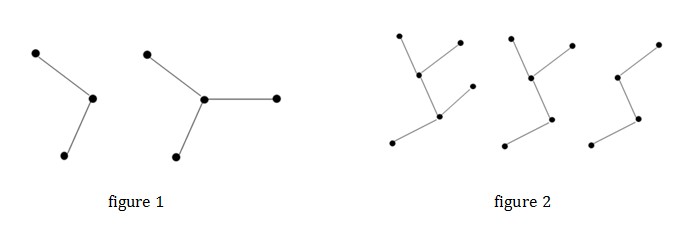标签:algorithm acm c++ 二叉树 计数
题意:求直径上有K个点的不同构树个数(每个点度不超过3)。
二叉树满足每个点度不超过3,把直径从中间切开,两边就是二叉树了。
设dp[i] = 深度为i的不同构二叉树个数。
sum[i] = 深度不超过i的不同构二叉树个数。
那么二叉树的两个分支有3种情况:
一个分支深度为i-1, 另一个分支深度小于i-1,有dp[i-1] * sum[i-2]种方法;
两个分支深度都是i-1,两个分支不一样,有dp[i-1]*(dp[i-1]-1)/2种方法;
两个分支深度都是i-1,两个分支一样,有dp[i-1]种方法。
dp[i] = dp[i-1]*sum[i-2] + dp[i-1]*(dp[i-1]+1)/2
i = K / 2
当K为偶数时,两边的二叉树深度都是K/2,
考虑两边可能相同,可能不同,方案数为dp[i]*(dp[i]+1)/2;
当K为奇数时,中间的点连接3个分支,至少有2个分支深度为K/2。
当3个分支有一个分支深度小于K/2,方案数 dp[i]*(dp[i]+1)/2*sum[i-1]
当3个分支深度都是K/2:
当3个分支都相同,方案数 dp[i]
当3个分支2个相同,方案数为 dp[i] * (dp[i] - 1)
当3个分支互不相同,方案数 C(dp[i], 3)
所有情况加起来就行了。
Yue Fei‘s Battle
Time Limit: 2000/1000 MS (Java/Others) Memory Limit: 512000/512000 K (Java/Others)
Total Submission(s): 194 Accepted Submission(s): 59
Problem Description
Yue Fei is one of the most famous military general in Chinese history.He led Southern Song army in the wars against the Jin dynasty of northern China. Yue Fei achieved a lot of victory and hopefully could retake Kaifeng ,the former capital of Song occupied
by Jin. Fearing that retaking Kaifeng might cause the Jin to release former Emperor Song Qinzong, threatening his throne, Emperor Song Gaozong took some corrupted officers‘ advice, sending 12 urgent orders in the form of 12 gold plaques to Yue Fei, recalling
him back to the capital.
Then Yue Fei was put into prison and was killed under a charge of "maybe there is" treason. But later Yue Fei was posthumously pardoned and rehabilitated, and became a symbol of loyalty to the country. The four corrupted officers who set him up were Qin Hui,Qin
Hui‘s wife Lady Wang, Moqi Xie and Zhang Jun. People made kneeling iron statues of them and put the statues before Yue Fei‘s tomb (located by the West Lake, Hangzhou). For centuries, these statues have been cursed, spat and urinated upon by people. (Now please
don‘t do that if you go to Hangzhou and see the statues.)
One of the most important battle Yue Fei won is the battle in Zhuxian town. In Zhuxian town, Yue Fei wanted to deploy some barracks, and connected those barracks with roads. Yue Fei needed all the barracks to be connected, and in order to save money, he wanted
to build as less roads as possible. There couldn‘t be a barrack which is too important, or else it would be attacked by enemies. So Yue Fei required that NO barrack could connect with more than 3 roads. According to his battle theory, Yue Fei also required
that the length of the longest route among the barracks is exactly K. Note that the length of a route is defined as the number of barracks lied on it and there may be several longest routes with the same length K.
Yue Fei wanted to know, in how many different ways could he deploy the barracks and roads. All barracks could be considered as no different. Yue Fei could deploy as many barracks as he wanted.
For example, if K is 3,Yue Fei had 2 ways to deploy the barracks and roads as shown in figure1. If K is 4, the 3 kinds of layouts is shown in figure 2. (Thick dots stand for barracks, and segments stand for roads):

Please bring your computer and go back to Yue Fei‘s time to help him so that you may change the history.
Input
The input consists of no more than 25 test cases.
For each test, there is only one line containing a integer K(1<=K<=100,000) denoting the length of the longest route.
The input ends by K = 0.
Output
For each test case, print an integer denoting the number of different ways modulo 1000000007.
Sample Input
Sample Output
Source
#include <bits/stdc++.h>
using namespace std;
#define prt(k) cerr<<#k" = "<<k<<endl
typedef long long ll;
const ll mod = 1e9 + 7;
ll pmod(ll a, ll n)
{
ll ret = 1;
for (; n; n>>=1, a=a*a%mod)
if (n&1)
ret = ret * a % mod;
return ret;
}
ll getinv(ll a)
{
return pmod(a, mod - 2);
}
const int N = 100100;
ll dp[N + 5], sum[N + 5];
const ll inv2 = getinv(2);
ll sub(ll a, ll b)
{
return (a - b + mod) % mod;
}
void init()
{
dp[0] = 1;
dp[1] = 1;
sum[0] = 1;
sum[1] = 2;
for (int i=1;i<N;i++)
{
dp[i+1] = (dp[i] * sum[i-1] % mod);
dp[i+1] = (dp[i+1] + (dp[i] + 1)%mod * dp[i] % mod * inv2 % mod) % mod;
sum[i+1] = (sum[i] + dp[i+1]) % mod;
}
}
ll C3(ll a)
{
return ((a*sub(a,1)%mod) * sub(a,2) % mod) * getinv(6) % mod;
}
ll f(int K)
{
int i = K / 2;
ll ans = ((dp[i] * (dp[i] + 1)%mod) % mod * inv2 % mod ) % mod;
ll tmp = ans;
if (K%2==0) {
return ans;
}
ans = (ans * sum[i-1]) % mod;
ans = (ans + dp[i]) % mod;
ans = (ans + (dp[i]-1+mod)%mod * dp[i] % mod) % mod;
ans = (ans + C3(dp[i])) % mod;
return ans;
}
int main()
{
int K;
init();
while (cin>>K, K)
{
ll ans = f(K);
cout<<ans<<endl;
}
return 0;
}
版权声明:本文为博主原创文章,未经博主允许不得转载。
HDU 5136 Yue Fei's Battle
标签:algorithm acm c++ 二叉树 计数
原文地址:http://blog.csdn.net/oilover/article/details/46756437
